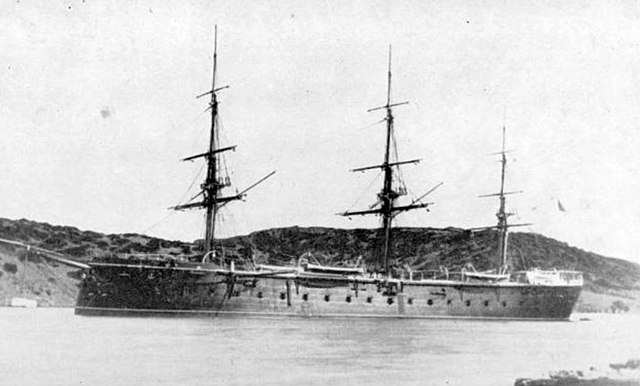
In its rapid expansion program, the Spanish Navy (Armada) chose to order it’s first ironclad in Britain. This was Vitoria (Victory), an iron-hulled armored frigate (single main artillery deck, secondary open deck) purchased in 1863. She took part on both sides in the Cantonal rebellion of 1873–1874, rebel first, and then after surrender, loyalist side. She played a major role in the Battle off Cartagena, ensured the government forces would win in the end. Vitoria also shelled rebel strongholds in 1874 to 1876, as part of the Third Carlist War. Reconstructed in the late 1890s she was reclassified as a coast-defense ship, and served in this role, in Spain when the 1898 Spanish-American war broke out. Postwar and until sold for BU in 1912 she served as training ship. #armada #vitoria #cantonalwar #carlistwa #1898 #ironclad #spanishnavy #ferrol
Development & Context
Spain in 1859 saw the launching and completion of Gloire as a wake up call for its ageing navy still composed of valuable three-decker man-o-war and frigates. Britain soon confirmed the trend by launching the iron-hulled Warrior. This was not a mere experiment and it seems a new arms race was on. Some in the naval staff were acutely aware that these ships were completely impervious to cannonball fire, and a single of these ironclads could rampage its fleet at any moment. Similar moves will happen also with Freshly Unified Italy, and Austria. They pleaded their cause to the Royal court, that vital interests of Spain and its Empire were at risk with this new naval “super weapon” (see the Armada composition. The two 85-guns ships of the line, four old 80-74 guns, three large screw frigates four sailing frigates, sloops, corvettes, gunboats and bricks were impressive on paper but not a match for any ironclads, and they were spread throughout the Empire.
Under Queen Isabel II, the navy advisor, convince of the emergency, obtained funding of an ambitious naval program in 1861, in which four broadside ironclads were to be ordered. The problem was that no Spanish Yard was able to built such ship yet. So at first two were ordered in France, the first at La Seyne, second to be built in Spain at the Ferrol Royal Dockyard (Galicia) with French parts and engineers. These were respectively Numancia and Tetuán.
The Queen approved this plan to make the Armada the fourth-largest naval power again. Due to the limitations of Spanish shipyards, general lack of industrial basis both to produce wrought iron or modern artillery, after the French, assistance was seeked from the British. They will provide one complete Ironclad (“Vitoria”, also an hommage from a queen to another and to commemorate a famous battle against Napoleon), and “Arapiles” in memory of the Battle of Salamanca. Here is the story of the first of these, Vitoria.
Order and construction of Vitoria
Vitoria was named after the 1813 Battle of Vitoria in the Napoleonic Wars, and ordered from the Thames Iron Works in December 1862 on Spanish specifications. A delegation was sent in Britain to supervise the redaction of more precise instructions and building process. She was laid down at Thames Ironworks, Blackwall shipyard in London, the following month. She was was launched on 4 November 1865, so almost three years after, and completed in May 1867 mostly due to delays in procuring artillery, and Spanish changes ion the design. She was commissioned at last in February 1868.
Design
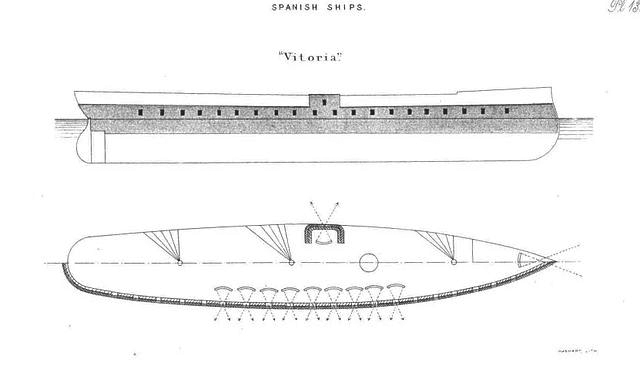
Hull and general layout
Vitoria was the first Spanish all iron hulled warship, unlike French ironclads, still wooden hulled. This notably explains why she was kept in service until 1912 in good conditions. Vitoria mesured 96.8 meters (317 ft 7 in) long, waterline, probably 110 m at the browsprit, and had a beam of 17.3 meters (56 ft 9 in), draft of 7.7 meters (25 ft 3 in). She displaced 7,250 metric tons or 7,135 long tons, so about the same of not more than Tetuan and Numancia. Her crew amounted to 561 officers and officers.
Powerplant:
She obtained a John Penn & Sons trunk steam engine. It drove a single four bladed bronze propeller shaft and was fed by eight squared boilers. Total output was 1,000 nominal horsepower, 4,500 indicated horsepower (3,400 kW) for a better speed than previous inronlads at 14 knots (26 km/h; 16 mph); Indeed Numancian was 13 kts, Tetuan 12 kts. For autonomy she carried 875 metric tons (861 long tons) of coal for an overall range of 2,400 nautical miles (4,400 km; 2,800 mi) at 10 knots cruise speed. Like the others to reduce coal consumption she could move under sail, and was rigged as a three-masted barque, with a sail area at the time marked as between 1,800 and 1,900 square meters (19,000–20,000 sq ft) with all outriggers out.
Armament:
Her main battery was originally thirty 68-pounder gun smoothbore guns, 15 per broadside. However technology progresses well and at the time of her completion in 1866-67 the yard proposed instead to have her equipped with brand new rifled muzzle-loading guns: She would be fitted with four Armstrong nine-inch (229 mm), three Armstrong eight-inch (203 mm), fourteen Trubia 160-millimeter (6.3 in) smoothbore guns used to support these with faster fire.
The 9-inch and 160-millimeter guns were located in the main gun deck, with two 9-in amidship, and 7 Trubia guns around. The three eight-inch guns were on the main deck, two on the broadside, another in the forecastle, as forward chase gun.
In 1883, there was a first refit and the old Trubia guns were replaced by four more 9-inch guns, two per side, for a broadside of four.
In 1896 Vitoria was refitted in France until 1898, modernized as a coast guard ship: She had six Spanish-manufactured Hontoria 160 mm guns, eight French Canet 140-millimeter (5.5 in) rifled breech-loading guns plus two 354-millimeter (14 in) torpedo tubes. She served in this guise until decommissioned in 1912.
Armour:
Vitoria was given a complete wrought iron waterline belt, 140 mm in thickness (5.5-in). Above the belt there was another protective layer to protect the battery and all except for the chase gun, were behind a 130 millimeters (5.1 in) armor plating. There were also 114 mm (4.5 in) barbettes around the upper 8-in guns. Both ends were unarmored, and that implied the steering. There was no conning tower, no deck protection.
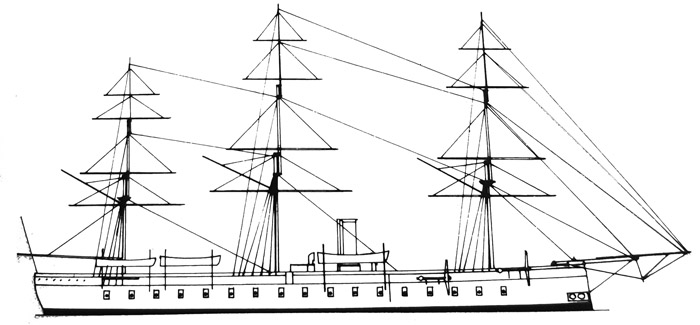
⚙ specifications |
|
| Displacement | 7,250 t (7,140 long tons) |
| Dimensions | 96.8 x 17.3 x 7.7m (317 ft 7 in x 56 ft 9 in x 25 ft) |
| Propulsion | 1 shaft, trunk steam engine, 8 boilers 4,500 ihp (3,400 kW), Ship rig |
| Speed | 14 knots (26 km/h; 16 mph) |
| Range | 2,400 nmi (4,400 km; 2,800 mi) at 10 knots, Unlimited with rig. |
| Armament | 4× 9 in (229 mm) RML, 3× 8 in (203 mm) RML, 14 × 160 mm (6.3 in) SB |
| Protection | Belt: 140 mm (5.5 in), Battery: 120 mm (4.7 in), Barbettes: 114 mm (4.5 in) |
| Crew | 584 |
Career of Vitoria
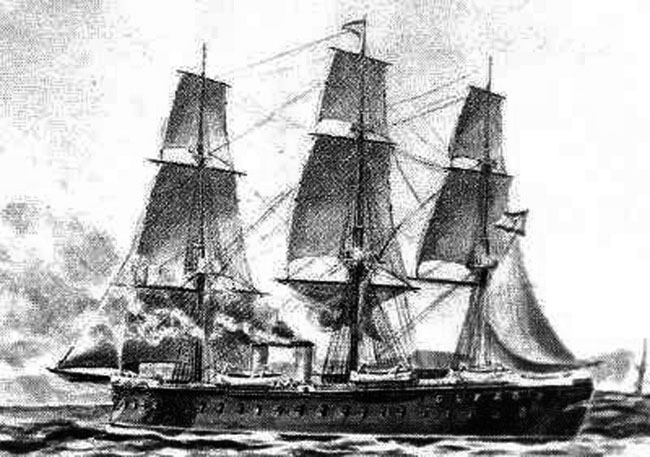
Vitoria was commissioned in February 1868 and sailed with her Spanish crew, which initially trained in British waters, to the Gluf of Gascony and bay of Biscaye, and from there, joind the Spanish coast. Her first action was at the Cantonal rebellion. At first where she was, the general mood was in favour of the rebels, and despite opposition of the officers, she joined their cause. When the Cantonists captured the port city of Cartagena, on the southern Mediterranean coast the whole of the Spanish Navy was concentrated there, and she joined the fleet. The armed steamer Vigilante sailed to Alicante to try to persuade the city to join the rebels. The uprising however saw Britain and Germany intervene and gathering an international squadron. They were not only worried for their own citizens and interests, but feared destabilization and a prolongated civil war.
Vitoria and the frigate Almansa sailed to Almería meanwhile and tried to onvince the city to join the cause, gun ports ostensibly open. The German commander of the international squadron Reinhold von Werner, decided to sent his flagship, the Prussian armored frigate SMS Friedrich Carl , backed by the ironclad HMS Swiftsure. They arrived off Almería, and at first a dialogue started, with the German Commander (Von Werner) trying to convince Vitoria and Almansa to leave the area. But as the latter did not answered or changed their stance, battle station was ordered. It seems discipline was left to be desired in both Spanish vessels as in no time, the twp ironclads fired volleys that overwhelm them. The brief engagement prompted a surrender. Von Werner lauinched a boarding party to discuss the surrender terms and sent the two ships under guard to Vice Admiral Hastings Yelverton, and both were later interned in British Gibraltar. They would be returned to the Spanish government after the rebel cause petered out. Back into service, Vitoria became flagship for the Spanish commander Admiral Lobo.
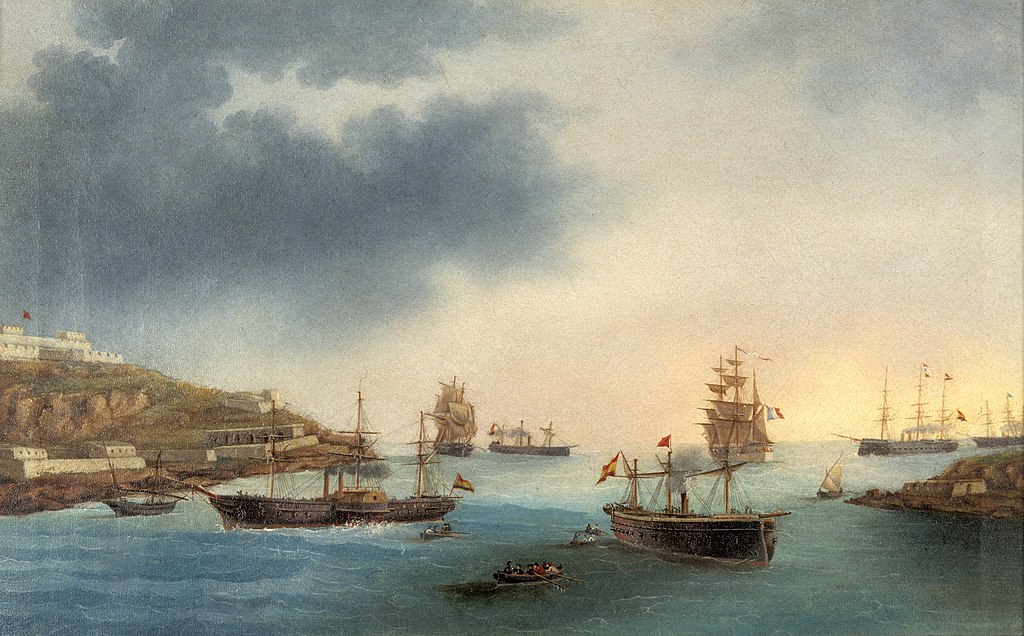
The battle of Cartagena in 1873
Vitoria then took part in the decisive Battle off Cartagena against the rebel fleet, on 11 October. This happened after the Loyalists blockaded Cartagena, the last Rebel stronghold, and the Rebel ships sorties peal-meal, attempting to break the blockade. Unable to forma line, they were sitting ducks. Vitoria engaged the flagship, the ironclad Numancia, at close range. Better trained, it was enough to convince her captain to veer back to port. Vitoria opened fire next on the casemate ship Méndez Núñez, and also damage her, making her flee. Vitoria then started a pursuit, until meeting in her way the French ironclad Thétis. The later let her pass however. She engaged next the rebel ironclad Tetuán at close range, but both rtemained unscaved, despite Vitoria having better guns. The siege went on until a new break through attempt, with the simimilar results. There was a thord attempt two days later, but Lobo this time, running short of everything, declined to engage and veered to the east.
But war was over when a new one erupted: The Third Carlist War.
On 1 January 1874, Vitoria fired warning shots at the British steamship Ellen Constance when leaving Cartagena. The British sailors later claimed she deliberately manoeuvered and sped up until she was rammed and sunk the steamship, with the loss of three of her crew. But the Spaniards officially apologized and attributed the collision as “poor seamanship”. This was indeed a matter of breaking diplomatic relations.
Cartagena was near to surrendering, when Numancia broke out in the night and manage to evaded the blocked on 12-13 January. She ended in the port of Oran, French North Africa. She was chased all the way by Vitoria and a wooden steamer until the French turned over control of the interned ship to Rear Admiral Nicolas Chicarro of the loyalist fleet on 18 January. Vitoria and the monitor Puigcerdá then spend the following motnsh to shell rebel-controlled towns until the end of the Third Carlist War (1872–1876).
The rest of her career is rather peaceful and unremarkable.
In February 1877 she carried King Alfonso XII from Alicante to Valencia and Tarragona, via Barcelona and Mahón in March. That same month, she made the opposite trip to Santa Pola, Almería, Málaga, Ceuta and Cádiz. In July she carried the king again, from Cádiz, to Santiago de Compostela.
There was a period of decline of the navy in the 1880s and like many remaining ironclads, Vitoria lacked proper maintenance and training. As tension rose with the US about Cuba in 1896 it was decided to rush the modernization of all ships available in case of war. After the order of a barbette battleship Pelayo in France in 1876.
On August 19, 1879, Vitoria was the first ship to use the new Campana dry dock in Ferrol. In 1892 she participated in Huelva, in the commemoration of the fourth centenary of the discovery of America, later visiting the port of Genoa (home of Cristobal Colon).
It was decided in 1890 to rebuilt four ironclads, notably the Vitoria and others. Vitoria, still in good shape, was to be modernized as a central-battery ironclad in the Mediterranean port and shipyard “arsenal of Forges et Chantiers de la Méditerranée” in La Seyne-sur-Mer near Toulon.
In 1896–1898 during this process, her sailing rig was cut down and replaced by two modern iron pole masts. Her artillery was modernized as well. She arrived on time, made ready for a possible US intervention on the Spanish coast. During the Spanish-American War she was part of Rear Admiral Cámara’s squadron, but never left Cádiz. She was reclassified as a coast-defense ship in 1899. Once the war was over, given shortage of ships, she became a part of the Training Squadron with her sister Numancia, Pelayo and the cruiser Carlos V.
In 1900, by Decree of May 18 of the Ministry of the Navy, 25 ships were decommissioned as they considered ineffective. Regarding the Vitoria:
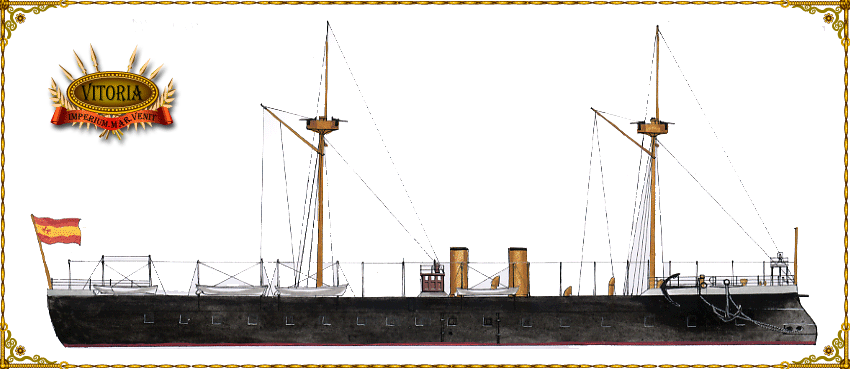
Vitoria in 1898
The Numancia and Vitoria, with little protection, although well distributed, with a single machine, a speed that does not exceed 11 miles and little artillery, can still be used for coastal defense or attack on poorly armed cities or ports. […] Art. 2. Of the remaining ships, the Numancia, the Vitoria and the Infanta Isabel will be decommissioned when they require the change of their current boilers or other important repairs or deficiencies. Art. 3. With the credits consigned in the current budget for the support of the personnel of the ships whose disarmament is expressed in art. 1st, the equipment of the Pelayo, Carlos V, Numancia, Vitoria and Nautilus will be completed and increased, as much as the current accommodations allow and those that can also be prudently built, both for Officers and Engineers, Petty Officers and other subordinate classes, with so that they dedicate themselves to the Instruction of their equipment, verifying continuous navigations and exercises of all kinds.
Postwar, it seems she kept this tole for a few more years, until being virtyually useless as training ship. Still she kept in service.
From 1903 she remained permanently anchored at El Ferrol as a barrack for the Artillery School until 1907, and placed into reserve. She was disarmed in 1908, sold for scrapping in 1911 for 277,254 pesetas, and stricken in 1912, broken up.
Read More/Src
Books
Greene, Jack & Massignani, Alessandro (1998). Ironclads at War: Origin and Development 1854–1891. Combined Publishing.
Lyon, Hugh (1979). “Spain”. In Gardiner, Robert (ed.). Conway’s All the World’s Fighting Ships 1860–1905. Conway Maritime Press.
de Saint Hubert, Christian (1984). “Early Spanish Steam Warships, Part II”. Warship International. XXI (1)
Silverstone, Paul H. (1984). Directory of the World’s Capital Ships. New York: Hippocrene Books.
Brassey, Thomas (1888). The Naval Annual 1887. Portsmouth, England: J. Griffin.
O’Shea, John Augustus (1896). “The Siege of Carthagena, 1873–74”. Battles of the Nineteenth Century. London: Cassel.
Pastor y Fernandez de Checa, M. (1977). “The Spanish Ironclads Numancia, Vitoria and Pelayo, Pt. II”.
“Spanish Ironclads Numancia and Vitoria”. Warship International. VIII (3): 287–289. 1970.
Links
alojados.revistanaval.com/
alojados.revistanaval.com vitoria.htm
en.wikipedia.org/ Spanish_ironclad_Vitoria
MERCHANT SHIPPING ACT—THE “ELLEN CONSTANCE” AND THE “VITTORIA.”—QUESTION. HC Deb 17 April 1874 vol 218 c711
commons.wikimedia.org/
es.wikipedia.org Vitoria_(1867)
https://todoavante.es/

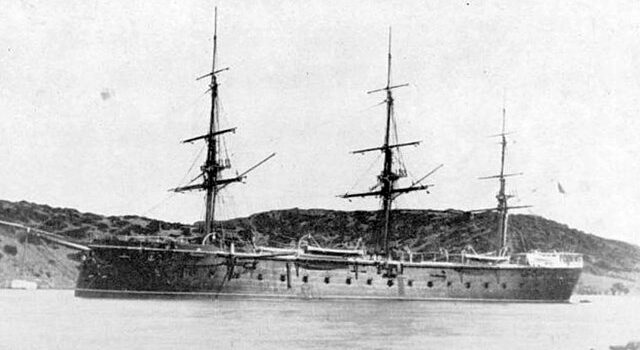

 Latest Facebook Entry -
Latest Facebook Entry -  X(Tweeter) Naval Encyclopedia's deck archive
X(Tweeter) Naval Encyclopedia's deck archive Instagram (@navalencyc)
Instagram (@navalencyc)





 French Navy
French Navy Royal Navy
Royal Navy Russian Navy
Russian Navy Armada Espanola
Armada Espanola Austrian Navy
Austrian Navy K.u.K. Kriegsmarine
K.u.K. Kriegsmarine Dansk Marine
Dansk Marine Nautiko Hellenon
Nautiko Hellenon Koninklije Marine 1870
Koninklije Marine 1870 Marinha do Brasil
Marinha do Brasil Osmanlı Donanması
Osmanlı Donanması Marina Do Peru
Marina Do Peru Marinha do Portugal
Marinha do Portugal Regia Marina 1870
Regia Marina 1870 Nihhon Kaigun 1870
Nihhon Kaigun 1870 Preußische Marine 1870
Preußische Marine 1870 Russkiy Flot 1870
Russkiy Flot 1870 Svenska marinen
Svenska marinen Søværnet
Søværnet Union Navy
Union Navy Confederate Navy
Confederate Navy Armada de Argentina
Armada de Argentina Imperial Chinese Navy
Imperial Chinese Navy Marinha do Portugal
Marinha do Portugal Mexico
Mexico Kaiserliche Marine
Kaiserliche Marine 1898 US Navy
1898 US Navy Sovietskiy Flot
Sovietskiy Flot Royal Canadian Navy
Royal Canadian Navy Royal Australian Navy
Royal Australian Navy RNZN Fleet
RNZN Fleet Chinese Navy 1937
Chinese Navy 1937 Kriegsmarine
Kriegsmarine Chilean Navy
Chilean Navy Danish Navy
Danish Navy Finnish Navy
Finnish Navy Hellenic Navy
Hellenic Navy Polish Navy
Polish Navy Romanian Navy
Romanian Navy Turkish Navy
Turkish Navy Royal Yugoslav Navy
Royal Yugoslav Navy Royal Thai Navy
Royal Thai Navy Minor Navies
Minor Navies Albania
Albania Austria
Austria Belgium
Belgium Columbia
Columbia Costa Rica
Costa Rica Cuba
Cuba Czechoslovakia
Czechoslovakia Dominican Republic
Dominican Republic Haiti
Haiti Hungary
Hungary Honduras
Honduras Estonia
Estonia Iceland
Iceland Eire
Eire Equador
Equador Iran
Iran Iraq
Iraq Latvia
Latvia Liberia
Liberia Lithuania
Lithuania Mandchukuo
Mandchukuo Morocco
Morocco Nicaragua
Nicaragua Persia
Persia San Salvador
San Salvador Sarawak
Sarawak Uruguay
Uruguay Venezuela
Venezuela Zanzibar
Zanzibar Warsaw Pact Navies
Warsaw Pact Navies Bulgaria
Bulgaria Hungary
Hungary

 Bundesmarine
Bundesmarine Dutch Navy
Dutch Navy Hellenic Navy
Hellenic Navy Marina Militare
Marina Militare Yugoslav Navy
Yugoslav Navy Chinese Navy
Chinese Navy Indian Navy
Indian Navy Indonesian Navy
Indonesian Navy JMSDF
JMSDF North Korean Navy
North Korean Navy Pakistani Navy
Pakistani Navy Philippines Navy
Philippines Navy ROKN
ROKN Rep. of Singapore Navy
Rep. of Singapore Navy Taiwanese Navy
Taiwanese Navy IDF Navy
IDF Navy Saudi Navy
Saudi Navy Royal New Zealand Navy
Royal New Zealand Navy Egyptian Navy
Egyptian Navy South African Navy
South African Navy






























 Ukrainian Navy
Ukrainian Navy dbodesign
dbodesign
Vitoria doesn’t mean “Victory” It’s the name of a Basque city site of a Peninsular War battle
oops, didn’t read the full article, it was explained later